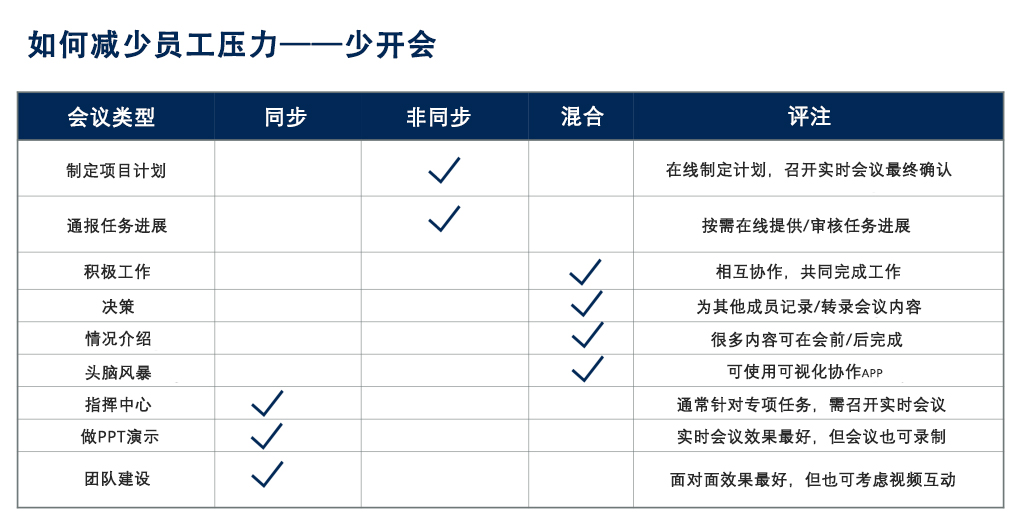
大部分會議都可以歸為九類:通報進展,、聽取報告,、頭腦風(fēng)暴等等。根據(jù)Gartner公司最近發(fā)布的研究,,在九種會議類型中,,只有三種需要全體成員同時參加,包括做PPT演示,、團隊建設(shè)和指揮中心(此時團隊往往需要對某一專項工作做出決策或?qū)ν獠渴录M行回應(yīng)。)
團隊會議過多可能會產(chǎn)生負(fù)面影響,,比如降低效率,、浪費公司的時間和經(jīng)費等。反過來說,,減少不必要的會議能夠提高員工參與度和產(chǎn)出,,防止員工產(chǎn)生倦怠感。當(dāng)前,,企業(yè)領(lǐng)導(dǎo)們正在尋求對抗“視頻會議疲勞”的解決之道,、提升員工的幸福感,、提供靈活的選擇等,這一切都是為了提高工作效率——從團隊日歷中刪除重復(fù)的會議可能會大有幫助,。
Gartner的副首席分析師塔潘·烏普曼宇在該公司舉辦的數(shù)字職場峰會(Digital Workplace Summit)上說:“如果公司真的重視而且希望降低員工的整體倦怠感和壓力,,他們就可以認(rèn)真研究一下每周的工作安排,找一找哪些會議能夠從同步會議或?qū)崟r會議轉(zhuǎn)變?yōu)榉峭交蚧旌夏J??!?/p>
同步會議是指需要所有員工同時出席的會議;在虛擬會議中,,就意味著每個人需要同時開著攝像頭參加同一場Zoom視頻會,。非同步會議可以通過電子郵件、Slack,,或者使用其他協(xié)作工具來實現(xiàn)與開會相同的效果,。不要求員工在特定的時間參會,也不要求實時參會,?;旌夏J绞莾烧呓Y(jié)合。
烏普曼宇說,,領(lǐng)導(dǎo)者應(yīng)該考慮取消討論項目計劃和通報最新進展的會議,,這些會議的內(nèi)容能夠采用非同步的方式進行線上分享、起草,、審核和編輯,。
“如果想通報項目進展,離線模式和開實時會議的效果一樣好,?!彼f,“所以為什么不把內(nèi)容放到一個可以編輯的文件中……任何想了解任務(wù)進展的人都能夠查閱這個文件,?!?/p>
某些會議類型更適合混合模式:積極工作、頭腦風(fēng)暴,、匯報和團隊決策,。它們往往會用到可視化組件(例如幻燈片或視頻)和文檔(比如會議記錄和議程)。但仍然不需要每個團隊成員都同時出席,。
烏普曼宇說:“這種情況下,,混合模式是更好的選擇,會前先將議程中不太重要的部分通過(異步協(xié)作工具)進行討論,,再開會”討論主要議題并做出最終決策,。

提高此類會議的靈活性還可以提升來自不同地區(qū)、使用不同工作模式的員工的參與度——這是人力資源主管和多元包容部門主管最關(guān)心的問題。研究顯示,,遠(yuǎn)程辦公的員工,、女性以及來自弱勢群體的員工在全體會議上的聲音往往更小。讓員工以非同步模式參與能夠提高團隊參與度,,加大集思廣益的范圍,。
“成功的協(xié)作和混合模式的關(guān)鍵在于能夠用平等流暢的方式會面、討論,、做決策并根據(jù)議程采取行動,。”烏普曼宇說,,“按照目前的開會方式,,可以肯定的是,遠(yuǎn)程辦公的員工會有被冷落的感覺……從而引起摩擦,、沮喪和不滿,。”(財富中文網(wǎng))
譯者:Agatha
大部分會議都可以歸為九類:通報進展,、聽取報告,、頭腦風(fēng)暴等等。根據(jù)Gartner公司最近發(fā)布的研究,,在九種會議類型中,,只有三種需要全體成員同時參加,包括做PPT演示,、團隊建設(shè)和指揮中心(此時團隊往往需要對某一專項工作做出決策或?qū)ν獠渴录M行回應(yīng),。)
團隊會議過多可能會產(chǎn)生負(fù)面影響,比如降低效率,、浪費公司的時間和經(jīng)費等,。反過來說,減少不必要的會議能夠提高員工參與度和產(chǎn)出,,防止員工產(chǎn)生倦怠感,。當(dāng)前,企業(yè)領(lǐng)導(dǎo)們正在尋求對抗“視頻會議疲勞”的解決之道,、提升員工的幸福感,、提供靈活的選擇等,這一切都是為了提高工作效率——從團隊日歷中刪除重復(fù)的會議可能會大有幫助,。
Gartner的副首席分析師塔潘·烏普曼宇在該公司舉辦的數(shù)字職場峰會(Digital Workplace Summit)上說:“如果公司真的重視而且希望降低員工的整體倦怠感和壓力,,他們就可以認(rèn)真研究一下每周的工作安排,找一找哪些會議能夠從同步會議或?qū)崟r會議轉(zhuǎn)變?yōu)榉峭交蚧旌夏J??!?/p>
同步會議是指需要所有員工同時出席的會議,;在虛擬會議中,,就意味著每個人需要同時開著攝像頭參加同一場Zoom視頻會,。非同步會議可以通過電子郵件、Slack,,或者使用其他協(xié)作工具來實現(xiàn)與開會相同的效果,。不要求員工在特定的時間參會,也不要求實時參會,?;旌夏J绞莾烧呓Y(jié)合。
烏普曼宇說,,領(lǐng)導(dǎo)者應(yīng)該考慮取消討論項目計劃和通報最新進展的會議,,這些會議的內(nèi)容能夠采用非同步的方式進行線上分享、起草,、審核和編輯,。
“如果想通報項目進展,離線模式和開實時會議的效果一樣好,?!彼f,“所以為什么不把內(nèi)容放到一個可以編輯的文件中……任何想了解任務(wù)進展的人都能夠查閱這個文件,?!?/p>
某些會議類型更適合混合模式:積極工作、頭腦風(fēng)暴,、匯報和團隊決策,。它們往往會用到可視化組件(例如幻燈片或視頻)和文檔(比如會議記錄和議程)。但仍然不需要每個團隊成員都同時出席,。
烏普曼宇說:“這種情況下,,混合模式是更好的選擇,會前先將議程中不太重要的部分通過(異步協(xié)作工具)進行討論,,再開會”討論主要議題并做出最終決策,。
資料來源:Gartner
提高此類會議的靈活性還可以提升來自不同地區(qū)、使用不同工作模式的員工的參與度——這是人力資源主管和多元包容部門主管最關(guān)心的問題,。研究顯示,,遠(yuǎn)程辦公的員工、女性以及來自弱勢群體的員工在全體會議上的聲音往往更小,。讓員工以非同步模式參與能夠提高團隊參與度,,加大集思廣益的范圍。
“成功的協(xié)作和混合模式的關(guān)鍵在于能夠用平等流暢的方式會面,、討論,、做決策并根據(jù)議程采取行動。”烏普曼宇說,,“按照目前的開會方式,,可以肯定的是,遠(yuǎn)程辦公的員工會有被冷落的感覺……從而引起摩擦,、沮喪和不滿,。”(財富中文網(wǎng))
譯者:Agatha
Most meetings fall under one of nine categories—status updates, debriefs, and brainstorming, to name a few. Of the nine meeting types, only three require that all employees attend at the same time, according to recently released research from Gartner. That truncated list includes presentations, team building, and command center (when teams make key decisions, often on an ad-hoc basis or in response to an external event).
Excessive team meetings can have negative consequences, tanking productivity and wasting company time and money. On the flip side, cutting back on superfluous meetings can improve engagement and output, and prevent employee burnout. As business leaders seek to combat “Zoom fatigue,” support employee well-being, and offer flexibility—all in an effort to drive workplace productivity—removing regularly-occurring meetings from team calendars can go a long way.
“If organizations are actually looking forward and serious about bringing down the overall burnout and stress on the employees, they can look into the work week and find out what are the meetings that actually can be transformed from synchronous, or live, to an asynchronous or blended approach,” said Tapan Upmanyu, associate principal analyst at Gartner, at the company’s Digital Workplace Summit.
Synchronous meetings are those where the presence of all employees is required at the same time; in a virtual setting this could mean everyone in a Zoom call with cameras on. Asynchronous meetings can occur via email, Slack, or utilize other collaboration tools to deliver the same outcomes as a meeting. They do not require every individual’s attendance at a specific time, nor does employee participation happen in real time. A blended approach refers to a mix of the two.
Leaders should consider axing meetings that discuss project planning and status updates, which can be shared, developed, reviewed, and edited online asynchronously, Upmanyu said.
“Status updates in live meetings are as good as status updates in an offline mode,” he said. “So why not take it down to a co-editable document…and anyone who wants to know and understand the updates of the task going on can go into that file.”
Certain meeting types are better suited for a blended model: active work, brainstorming, debriefs, and making team decisions. They typically involve visual components such as slideshows or videos, and documentation such as meeting notes and an agenda. But they still do not require every team members’ live attendance.
"It is better to use a blended approach when the agenda’s less important points are actually discussed prior to the meeting through [asynchronous collaboration tools] and then go into the meetings” to discuss primary points and finalize decisions, Upmanyu said.
Improving flexibility around these kinds of meetings can also allow for greater participation across geographies or work models—a top concern for HR leaders and D&I heads. Remote employees, women, and those from underrepresented groups tend to be less vocal in all-hands meetings, research shows. Allowing workers to participate asynchronously can bolster team involvement and widen the breadth of ideas sourced.
“The key to a successful collaboration and hybrid model is the ability to meet, discuss, decide and act upon agendas in an equal and frictionless manner,” Upmanyu said. “The way meetings have been conducted so far, it is certain that the remote employees actually feel a little left out…leading to friction, frustration, and dissatisfaction.”






